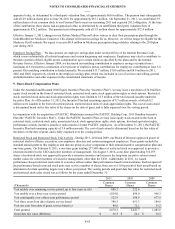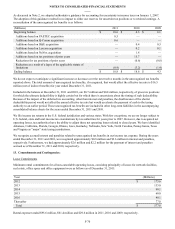Windstream 2011 Annual Report Download - page 170
Download and view the complete annual report
Please find page 170 of the 2011 Windstream annual report below. You can navigate through the pages in the report by either clicking on the pages listed below, or by using the keyword search tool below to find specific information within the annual report.
NOTES TO CONSOLIDATED FINANCIAL STATEMENTS
____
F-62
qualified pension plan assets includes a targeted asset allocation of 55.0 percent to equities, 35.0 percent to fixed income
securities, and 10.0 percent to alternative investments, with an aggregate expected long-term rate of return of approximately 8.0
percent.
Information regarding the healthcare cost trend rate was as follows for the years ended December 31:
Healthcare cost trend rate assumed for next year
Rate that the cost trend ultimately declines to
Year that the rate reaches the terminal rate
2011
9.00%
5.00%
2017
2010
9.00%
5.00%
2017
For the year ended December 31, 2011, a one percent increase in the assumed healthcare cost trend rate would increase the
postretirement benefit cost by approximately $0.2 million, while a one percent decrease in the rate would reduce the
postretirement benefit cost by approximately $0.2 million. As of December 31, 2011, a one percent increase in the assumed
healthcare cost trend rate would increase the postretirement benefit obligation by approximately $4.9 million, while a one
percent decrease in the rate would reduce the postretirement benefit obligation by approximately $4.0 million.
Plan Assets – Our pension plan assets are allocated to asset categories based on the specific strategy employed by the asset’s
investment manager. The asset allocation at December 31, 2011 and 2010 for our pension plan by asset category were as
follows:
Asset Category
Equity securities
Fixed income securities
Alternative investments
Money market and other short-term interest bearing securities
Target Allocation
2012
50.0% - 65.0%
30.0% - 45.0%
0.0% - 10.0%
0.0% - 5.0%
Percentage of Plan Assets
2011
50.8%
39.2%
3.7%
6.3%
100.0%
2010
61.1%
34.9%
0.2%
3.8%
100.0%
Our investment strategy is to maintain a diversified asset portfolio expected to provide long-term asset growth. Asset allocation
decisions reflect the return objectives of the pension plan as well as tolerance for risk, liquidity needs and future funding
obligations. The long-term return objective is to satisfy any current funding obligations when and as prescribed by law and to
keep pace with the growth of the pension plan liabilities. Given the long time horizon for paying out benefits, and our strong
financial condition, the pension plan can accept an average level of risk relative to other similar plans. The liquidity needs of
the plan are manageable given that lump sum payments are not available to most participants.
Equity securities include stocks of both large and small capitalization domestic and international companies. Equity securities
are expected to provide both diversification and long-term real asset growth. Domestic equities may include modest holdings of
non-U.S. equities, purchased by domestic equity managers as long as they are traded in the U.S and denominated in U.S.
dollars and both active and passive (index) investment strategies. International equities provide a broad exposure to return
opportunities and investment characteristics associated with the world equity markets outside the U.S. The plan’s equity
holdings are diversified by investment style, market capitalization, market or region, and economic sector.
Fixed income securities include securities issued by the U.S. Government and other governmental agencies, asset-backed
securities and debt securities issued by domestic and international companies. These securities are expected to provide
significant diversification benefits, in terms of asset volatility and pension funding volatility, and a stable source of income.
Alternative investments include both private and public real estate and private equity investments. In addition to attractive
diversification benefits, the real estate investments are expected to provide both income and capital appreciation, while the
private equity investments are expected to provide return enhancements.
Investments in money market and other short-term interest bearing securities are maintained to provide liquidity for benefit
payments with protection of principal being the primary objective.
At its meeting on February 9, 2011, the board of directors approved a measure to allow the plan to make investments in our
common stock. Previously, the plan prohibited investment in our common stock. This change allowed us to make 2011 pension
contributions of $135.8 million in our common stock. We are not required to make a pension contribution in 2012, but can
make a contribution on a voluntary basis.
























